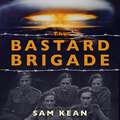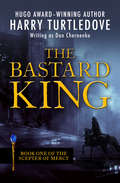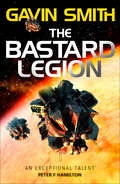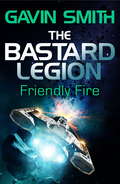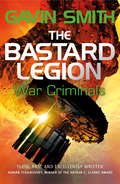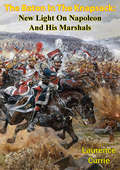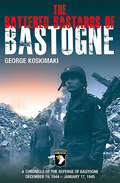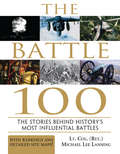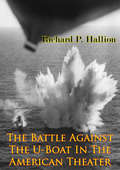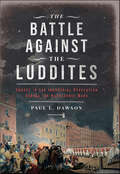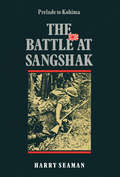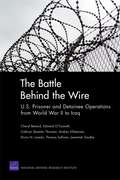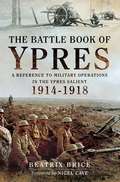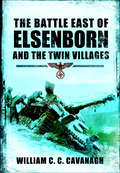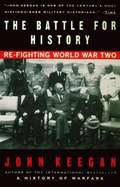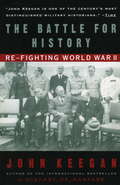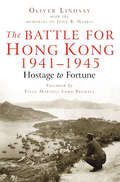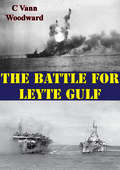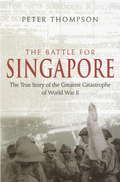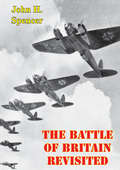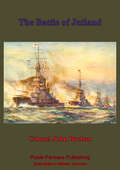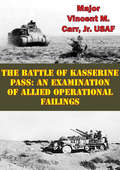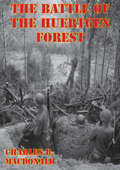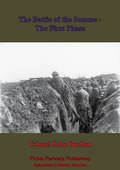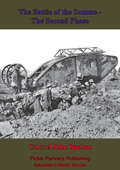- Table View
- List View
The Bastard Brigade: The True Story of the Renegade Scientists and Spies Who Sabotaged the Nazi Atomic Bomb
by Sam KeanNew York Times bestselling author Sam Kean tells the incredible story of how a renegade group of spies kept Hitler from obtaining his ultimate prize: a nuclear bomb.Scientists have always kept secrets. But rarely in history have scientific secrets been as vital as they were during World War II. In the midst of planning the Manhattan Project, the U.S. Office of Strategic Services created a secret offshoot - the Alsos Mission - meant to gather intelligence on and sabotage if necessary, scientific research by the Axis powers. What resulted was a plot worthy of the finest thriller, full of spies, sabotage, and murder. At its heart was the 'Lightning A' team, a group of intrepid soldiers, scientists, and spies - and even a famed baseball player - who were given almost free rein to get themselves embedded within the German scientific community to stop the most terrifying threat of the war: Hitler acquiring an atomic bomb of his very own.While the Manhattan Project and other feats of scientific genius continue to inspire us today, few people know about the international intrigue and double-dealing that accompanied those breakthroughs. Bastard Brigaderecounts this forgotten history, fusing a non-fiction spy thriller with some of the most incredible scientific ventures of all time.(P) 2019 Hachette Book Group Audio Ltd
The Bastard King (The Scepter of Mercy #1)
by Harry TurtledoveTwo rivals must unite to prevent a disgraced malevolent god from attaining a relic of extraordinary power in the first book of alternate history master Harry Turtledove's magnificent fantasy trilogy More than four centuries ago, the Scepter of Mercy was lost to the king of Avornis, and each subsequent liege has promised--and failed--to return the powerful talisman to its rightful home. Now, young Lanius, the only surviving son of King Mergus, rules, though he is considered illegitimate and must abide by the decisions of regents. Still, the legacy of the missing scepter ultimately belongs to him. But it is also coveted by the Banished One, an immortal exiled by the other gods, who invades the world of men through their dreams. Lanius, with no talent or heart for battle, must keep those in the sway of the malevolent deity from Avornis's borders. To this end, Lanius requires the help of Grus, a fearless and respected captain of the king's navy. But Grus has a far loftier destiny than his common birth would suggest--and the bastard king's brave, accomplished ally might well turn out to be his most dangerous adversary. Originally published under the pen name Dan Chernenko, The Bastard King is a magnificent foray into epic fantasy by the incomparable Harry Turtledove, the prolific and multi-award-winning master of alternate history science fiction. A tale of courage and destiny, it is alive with action, imagination, and humanity, and populated by richly complex, imperfect heroes and a villain as truly fiendish as any that has ever graced the fantasy genre.
The Bastard Legion: Book 1 (The Bastard Legion)
by Gavin G. Smith'High octane SF adventure with Smith's trademark twist' Jamie Sawyer'An exceptional talent' Peter F HamiltonFour hundred years in the future, the most dangerous criminals are kept in suspended animation aboard prison ships and "rehabilitated" in a shared virtual reality environment. But Miska Corbin, a thief and hacker with a background in black ops, has stolen one of these ships, the Hangman's Daughter, and made it her own. Controlled by explosive collars and trained in virtual reality by the electronic ghost of a dead marine sergeant, the thieves, gangsters, murderers, and worse are transformed into Miska's own private indentured army: the Bastard Legion. Are the mercenaries just for fun and profit, or does Miska have a hidden purpose connected to her covert past?'Gloriously action-packed and often brutal military SF adventure . . . This series launch will keep readers turning pages, eager to see what bloody adventure awaits and how the legion develops into a force to be reckoned with' Publishers Weekly STARRED REVIEW
The Bastard Legion: Book 2
by Gavin G. Smith'High octane SF adventure with Smith's trademark twist' Jamie Sawyer, author of The Lazarus War'An exceptional talent' Peter F HamiltonIn FRIENDLY FIRE, the Bastard Legion are hired to pull off a daring power-armoured heist of propriety tech. A crime-ridden colony world holds the secret to a potential alien contact, and various groups of mercenaries have been hired to discover it. None of the rest of them have little bombs implanted in their heads, though, so the Bastards have an advantage when it comes to motivation. And Miska, their commander and kidnapper both, is still on the hunt for the people who killed her father. People who might still be among her convicts.Getting the tech will be hard. Getting off the planet, deadly.'a brutal kaleidoscope of imagination' Hannu Rajaniemi, author of The Quantum Thief
The Bastard Legion: Book 3 (The\bastard Legion Ser.)
by Gavin G. SmithDirty, gritty and action-packed adventure featuring the galaxy's deadliest mercenaries, THE BASTARD LEGIONMILITARY SCIENCE FICTION AT ITS BEST. 'High octane SF adventure with Smith's trademark twist' Jamie Sawyer, author of The Lazarus War It was the kind of dirty, violent work the Bastards were made for. Protect a bunch of colonists in the Epsilon Eridani system, whose moon had become a war zone as megacorp-backed mercenaries fought a brutal proxy war. Just the kind of fight the penal mercenary legion liked. But a hundred headless corpses are hard to explain, even for the Bastard Legion, and soon they are on the run, abandoned by their allies, and hunted by their most dangerous foe yet . . . but Miska's going to play them at her own game. The Bastard Legion: the galaxy's most dangerous criminals controlled by implanted explosives and trained by the electronic ghost of a dead marine. 'Gloriously action-packed and often brutal military SF adventure . . .' Publishers Weekly 'An exceptional talent' Peter F HamiltonA 'Dirty Dozen' or 'Suicide Squad' for lovers of 'Aliens', THE BASTARD LEGION series is a down and dirty military SF set in a world of mercenary actions and covert operations.
The Baton In The Knapsack: New Light On Napoleon And His Marshals
by Laurence CurrieTHE purpose of this book is to sketch briefly the career of Napoleon, especially his relations with his marshals, and to consider how far the marshals were responsible for the rise of the Napoleonic Empire and how some of them at any rate contributed to its fall.It was a saying among the rank and file of the armies of revolutionary France that every soldier carried in his knapsack the bâton of a marshal. This was to prove truer than is usual with such dicta; for more than half of Napoleon's marshals did actually arise from the ranks.In reviewing the period, the student of history can hardly fail to be fascinated by the deeds of valour casting a halo of romance over the entire epoch and to feel that wars productive of so many heroes can hardly have been fought in vain.Mechanical inventions have since degraded the art of war, robbed it of all glamour and added greatly to its horrors. Cavalry charges, such as those which proved decisive at Marengo and at Friedland, are now impossible; but, so long as mankind takes any interest in the past, the story of these mighty contests will always stir the imagination and perhaps excite the envy of future generations.
The Battered Bastards of Bastogne: A Chronicle of the Defense of Bastogne December 19, 1944–January 17, 1945
by George Koskimaki&“Fleshes out in vivid detail the entire story of the Screaming Eagles&’ valiant struggle . . . This is must reading for any student of World War II history&” (Kepler&’s Military History).The Battered Bastards of Bastogne is the product of contributions by 530 soldiers who were on the ground or in the air over Bastogne. They lived and made this history, and much of it is told in their own words. The material contributed by these men of the 101st Airborne Division, the Armor, Tank Destroyer, Army Air Force , and others is tailored meticulously by the author and placed on the historical framework known to most students of the Battle of the Bulge. Pieces of a nearly 60-year-old jigsaw puzzle come together in this book, when memoirs from one soldier fit with those of another unit or group pursuing the battle from another nearby piece of terrain.
The Battle 100
by Michael Lee LanningA single day in the heat of armed conflict can shape the future of the world. Throughout history, individual battles have inspired the birth of nations, the devastation of cultures and the triumph of revolutions. Yet while some battles rise up as the cornerstones of history, others fade in our cultural memory, forgotten as minor skirmishes. Why is this so? What makes a battle "important"?Celebrated veteran and military expert Michael Lee Lanning offers a provocative response with The Battle 100: The Stories Behind History's Most Influential Battles. Lanning ranks history's 100 greatest battles according to their influence, both immediate and long-term. Thought-provoking and controversial, Lanning's rankings take us to the heart of the battles and reveal their true greatness.
The Battle Against The U-Boat In The American Theater [Illustrated Edition] (The U.S. Army Air Forces in World War II #6)
by Richard P. HallionIncludes 20 IllustrationsIn 1942 the Allied powers faced the most serious challenge to their control of the seas encountered in the Second World War: the menace of the U-boat. Fast, well- armed, and long-ranged, Hitler's submarines attacked shipping throughout the North Atlantic, often within sight of America's coastal towns and cities.Eventually, the combination of intelligence, land and sea- based air power, and surface vessel operations from both North American and British bases ended this threat, making possible the Allied build-up for the invasion of Europe in 1944.Flying radar-equipped long-range patrol planes, AAF airmen demonstrated the value of land-based air power against naval threats. This success has been reaffirmed consistently since the Second World War, from Vietnam and crises such as the Mayaguez incident to operations in Desert Shield and Desert Storm. The Harpoon-armed B-52s of our present-day global Air Force are the heirs of a sea-control tradition dating to the AAF's A-29s and B-24s of the Second World War.
The Battle Against the Luddites: Unrest in the Industrial Revolution During the Napoleonic Wars
by Paul L. DawsonAs the columns of French infantry marched up the slopes of the Mont St Jean at Waterloo, the British heavy cavalry, the Royal Scots Greys to the fore, crashed into the packed ranks of the enemy. This was not the first time the Greys had drawn their swords during the Napoleonic Wars – but it was their first against Napoleon’s troops. Three years earlier they had attacked workers in Halifax protesting at the introduction of machinery in the wool trade. Taking their name from Ned Ludd, who had smashed up knitting frames in Nottingham, the Luddites saw the emergence of mechanization as a threat to their livelihood, with machines replacing men. In response they took matters into their own hands by wrecking the new equipment. Industrial unrest had gathered pace throughout the 18th century and exploded in an unpresented wave of violence in 1799. Outbreaks of machine-breaking developed rapidly into strikes in a battle of capital against labor. A court battle ensued, culminating in new legislation in 1806 that backed the capitalists. This act, coupled with the impact of the Continental system introduced by Napoleon, which closed European and American ports to British merchants, heralded the largest economic depression of the era. Famine, pestilence and rising employment all fueled the fires of Luddism. Months of violence swept across the West Midlands, Lancashire and Yorkshire which saw one factory boss murdered; other factory owners began shooting protesting workers. The disturbances resulted in the mobilizing of thousands of regular soldiers – at one time there were as many British soldiers fighting the Luddites than there were fighting Napoleon on the Iberian Peninsula. As well as exploring these events, Paul L. Dawson also uncovers the origins of Luddism and their allies in the middle classes. The Napoleonic Wars marked the end of centuries old way of life in agriculture, textile production and the wider economy. The dramatic changes in Britain between 1790 and 1815 created a unique set of social grievances by those left behind by the unprecedented changes that were surging through the Britain which exploded into bitter fighting across large swathes of the country. With present day concerns over computerization replacing labor, this is a story that echoes down the centuries.
The Battle At Sangshak: Prelude to Kohima
by Harry SeamanThis book tells the story of a small, yet significant, battle that was a precursor to the better known battles for Imphal and Kohima.
The Battle Behind the Wire: U. S. Prisoner and Detainee Operations from World War II to Iraq
by Cheryl Benard Edward O'Connell Cathryn Quantic Thurston Andres Villamizar Elvira N. LoredoThis report finds parallels in U.S. prisoner and detainee operations in World War II, Korea, Vietnam, and Iraq: underestimation of the number to be held, hasty scrambling for resources, and inadequate doctrine and policy. Later, attempts to educate and influence prisoners and detainees are often made. The authors recommend that detailed doctrine should be in place prior to detention and that detainees should be interviewed when first detained.
The Battle Book of Ypres: A Reference to Military Operations in the Ypres Salient 1914–1918
by Beatrix BriceOf the many hard-fought battles on the Western Front, Ypres stands out as an example of almost inhuman endeavour. For four long years it was the focal point of desperate fighting. Officially there were four main battles in 1914, 1915, 1917 and 1918; these were more accurately peaks in a continuing struggle, for Ypres symbolised Belgian defiance, and the British continued to expend disproportionate resources on defending it. It never fell, although the Germans came close to its gates, and indeed its loss would have been a severe blow to morale.The Battle Book of Ypres, originally published in 1927 and now presented again as a special Centenary Edition, comprises a chronological account of the fighting in the Ypres Salient during the First World War, followed by a useful and unique alphabetical reference to the events in and around each hamlet, village or wood names familiar to those who fought or followed the course of war all those years ago, names now once again lost in insignificance. The names given to each stage of the struggle by the Battle Nomenclature Committee are listed in the appendix. Also included is an index of formations and units, an annotated bibliography and a new Foreword by military historian Nigel Cave.
The Battle East of Elsenborn and the Twin Villages
by William C. CavanaghA US Army historian chronicles a vital zone of conflict within The Battle of the Bulge in this authoritative and detailed account of WWII combat. With Allied forces encroaching on all fronts, Hitler made one final, desperate offensive in the Ardennes. While The Battle of the Bulge is extensively written about in histories of the Second World War, this book focuses on a critical but seldom explored aspect of the conflict: the five-day critical battle for the North shoulder of the Bulge at Rochearth-Krinkelt. The Bulge was fought was fought in many areas, but for the soldiers of the First Army—six of whom were awarded Congressional Medals of Honor for their brave acts during the engagement—it was won on this shoulder. Military historian William Cavanagh has studied official after-action reports, histories and unit reports of organizations involved in the battle. In addition, he has conducted an extensive program of individual contacts, not only with the US Army participants, local villages and resistance fighters, but also with German commanders at various levels in the three divisions involved. Having lived in the Ardennes for many years and served as a principle researcher for the Deputy Chief Historian for the United States Army, Cavanagh brings a rare insight and expertise to his subject.
The Battle For History: Re-fighting World War II
by John KeeganA fascinating guide to the history and historiography surrounding the Second World War.
The Battle For History: Re-fighting World War II
by John KeeganWith the same erudition, discernment, and crisp prose that made his A History of Warfare an international bestseller, Keegan surveys the literature of World War II, identifying the works he finds most important and illuminating while examining the sometimes savage controversies raised by two generations of the war's historians.From the Trade Paperback edition.
The Battle For Hong Kong 1941-1945: Hostage to Fortune
by Oliver LindsayIn this remarkable study of the Far Eastern War, Oliver Lindsay and John R Harris have provided the most thorough and searching enquiry into the debacle which led to over 12,000 British, Canadian, Indian and Chinese defenders surrendering Hong Kong on Christmas Day 1941. The authors have made use of a mass of unpublished material - part of it drawn from the original war diaries which have never before been in the public domain. Although it is over 60 years since Hong Kong was liberated from the Japanese, numerous important questions regarding the war in the East and occupation of the Colony from 1941 to 1945 have not been explored until now. To what extent, for example, were Churchill and the successive Chiefs of the Imperial General Staff responsible for abandoning this outpost, which could not be reinforced when attacked or defended adequately? Is it true that fine leadership prolonged the fighting, inflicting serious casualties on the highly experienced Japanese when they struck in 1941? How useful was Britain's spying organization in China, which led to catastrophic repercussions for the POWs and Internees? What form did the Japanese atrocities take upon the helpless captives? This detailed and authoritative account of the campaign will provide a particularly compelling read for those interested in the Second World War or the history of the Far East.
The Battle For Leyte Gulf [Illustrated Edition]
by C. Vann WoodwardIncludes 6 charts and 20 photosPulitzer prize winning author C. Vann Woodward recounts the story of the largest naval battle of all time."The Battle for Leyte Gulf was the greatest naval battle of the Second World War and the largest engagement ever fought on the high seas. It was composed of four separate yet closely interrelated actions, each of which involved forces comparable in size with those engaged in any previous battle of the Pacific War. The four battles, two of them fought simultaneously, were joined in three different bodies of water separated by as much as 500 miles. Yet all four were fought between dawn of one day and dusk of the next, and all were waged in the repulse of a single, huge Japanese operation."They were guided by a master plan drawn up in Tokyo two months before our landing and known by the code name Sho Plan. It was a bold and complicated plan calling for reckless sacrifice and the use of cleverly conceived diversion. As an afterthought the suicidal Kamikaze campaign was inaugurated in connection with the plan. Altogether the operation was the most desperate attempted by any naval power during the war-and there were moments, several of them in fact, when it seemed to be approaching dangerously near to success."Unlike the majority of Pacific naval battles that preceded it, the Battle of Leyte Gulf was not limited to an exchange of air strikes between widely separated carrier forces, although it involved action of that kind. It also included surface and subsurface action between virtually all types of fighting craft from motor torpedo boats to battleships, at ranges varying from point-blank to fifteen miles, with weapons ranging from machine guns to great rifles of 18-inch bore, fired "in anger" by the Japanese for the first time in this battle."
The Battle For Singapore: The true story of the greatest catastrophe of World War II
by Peter ThompsonThe Fall of Singapore on 15 February 1942 is a military disaster of enduring fascination. For the 60th anniversary of the liberation of the island, Peter Thompson tells the explosive story of the Malayan campaign, the siege of Singapore, the ignominious surrender to a much smaller Japanese force, and the Japanese occupation through the eyes of those who were there - the soldiers of all nationalities and members of Singapore's beleaguered population. An enthralling and perceptive account, which never loses sight of the human cost of the tragedy - Yorkshire Evening Post. An insightful and dramatic analysis - The Good Book Guide
The Battle Of Britain Revisited
by Group Captain John H. SpencerThe North Atlantic Treaty Organization (NATO) was formed as, and remains, a defensive alliance. It is axiomatic therefore, that in the event of a war in Europe, NATO forces would be initially on the defensive. It is also likely that the Warsaw Pact (WP) forces would use all the considerable means at their disposal to achieve their war aims, including air power, and in the past 50 years or so, air power has had a considerable, some would even say a decisive, role to play in the conduct of war. From the foregoing, it can be seen that NATO air defences would be a vital pillar in the overall defence of Western Europe and that should they fail, or be overcome, then the achievement of NATO war aims would be made very much more difficult. In this context, it would seem worthwhile to examine one of the very few air defence campaigns of the past that succeeded and to see what lessons can be learnt from it that have relevance for today.Arguably, the most notable example of a successful air defence campaign was the Battle of Britain, which took place in the summer and autumn of 1940. Many books articles, and reminiscences have been published about the struggle and this study does not intend to give a detailed blow-by-blow account but rather to analyse the campaign and highlight those aspects which seem of particular importance to the outcome of the battle. It may be that some of these illuminate the eternal verities of warfare and are therefore as important today as they ever were.
The Battle Of Jutland
by Colonel John BuchanThe one and only major naval engagement of the First World War stands alone in the history of Warfare afloat. It is a curious battle to study as a German tactical victory, but rather a British strategic victory. Colonel Buchan wrote his volume study of the battle from an enviable position as a high ranking intelligence officer, having access to much of the detail from the allied side. He divided the action into four distinct phases as the battle ships and cruisers manoeuvred for position and the shells rained among them. One of the finest British authors of the age, he also wrote copious numbers of books on the First World War, of particular note the 24 volume "Nelson's" history.
The Battle Of Kasserine Pass: An Examination Of Allied Operational Failings
by Major Vincent M. Carr Jr. USAFThe Battle of Kasserine Pass proved to be a shock both to American military forces in the field and to the American public at home. The defeat of the Allied forces in the battle put doubt into the minds of many--all of whom assumed the righteous democracies of the western Allies could not be defeated in the field by the armies of Fascism. The defeat suffered by the Allies had nothing to do with right versus wrong, however, but was very much a product of a number of operational shortcomings on the part of the Allies. Poor logistics, failures on the part of American leadership, lack of unity of effort on the part of the Allies, the lack of combat experience, and inferior equipment all combined to contribute to the failure at Kasserine. Despite the setback at Kasserine Pass, the Americans proved quick learners, and applied the lessons of the North African experience to the remainder of their campaign in the European theater.
The Battle Of The Huertgen Forest [Illustrated Edition]
by Charles Brown MacdonaldIncludes the Siegfried Line Campaign Map Pack - 19 maps and 81 photos“"A testament of the courage and endurance of our fighting men."-New York Times“In September 1944, three months after the invasion of Normandy, the Allied armies prepared to push the German forces back into their homeland. Just south of the city of Aachen, elements of the U.S. First Army began an advance through the imposing Huertgen Forest. Instead of retreating, as the Allied command anticipated, the German troops prepared an elaborate defense of Huertgen, resulting in a struggle where tanks, infantry, and artillery dueled at close range. The battle for the forest ended abruptly in December, when a sudden German offensive through the Ardennes to the south forced the Allied armies to fall back, regroup, and start their attack again, this time culminating in the collapse of the Nazi regime in May 1945.“In The Battle of the Huertgen Forest, Charles B. MacDonald assesses this major American operation, discussing the opposing forces on the eve of the battle and offering a clearly written and well-documented history of the battle and the bitter consequences of the American move into the forest. Drawing on his own combat experience, MacDonald portrays both the American and the German troops with empathy and convincingly demonstrates the flaws in the American strategy. The book provides an insight into command decisions at both local and staff levels and the lessons that can be drawn from one of the bloodiest battles of World War II.“Charles B. MacDonald was deputy chief historian of the Army Center of Military History. He commanded a rifle platoon in World War II, earning the Silver Star, a Purple Heart, and five battle stars. He recorded his wartime experiences in Company Commander, regarded as one of the finest World War II combat narratives.”-Print Ed.
The Battle Of The Somme - The First Phase. [Illustrated Edition]
by Colonel John BuchanMore than any other battle of the First World War, the battle of the Somme remains as the abiding memory of the appalling conditions, suffering and death of British manhood in the public consciousness. As the guns stopped their bombardment on the 1st of July, the waves of Allied troops walked toward the often still intact German lines. More than a million men in total would be killed, wounded or captured on both sides before the fighting subsided in November.Colonel Buchan wrote his volume study of the battle from an enviable position as a high ranking intelligence officer, having access to much of the detail from the allied side of the offensive. One of the finest British authors of the age, he also wrote copious numbers of books on the First World War, of particular note the 24 volume 'Nelson's" history.Author -- Colonel Buchan, John, (Later Lord Tweedsmuir) 1875-1940.Text taken, whole and complete, from the edition published in London, T. Nelson and sons, ltd. 1916.Original Page Count - 108 pages.Illustrations -- numerous illustrations and plates
The Battle Of The Somme –The Second Phase. [Illustrated Edition]
by Colonel John BuchanMore than any other battle of the First World War, the battle of the Somme remains as the abiding memory of the appalling conditions, suffering and death of British manhood in the public consciousness. As the guns stopped their bombardment on the 1st of July, the waves of Allied troops walked toward the often still intact German lines. More than a million men in total would be killed, wounded or captured on both sides before the fighting subsided in November.Colonel Buchan wrote his volume study of the battle from an enviable position as a high ranking intelligence officer, having access to much of the detail from the allied side of the offensive. One of the finest British authors of the age, he also wrote copious numbers of books on the First World War, of particular note the 24 volume 'Nelson's" history.Author -- Colonel Buchan, John, (Later Lord Tweedsmuir) 1875-1940.Text taken, whole and complete, from the edition published in London, T. Nelson and sons, ltd. 1916.Original Page Count - 108 pages.Illustrations -- numerous illustrations and plates.
